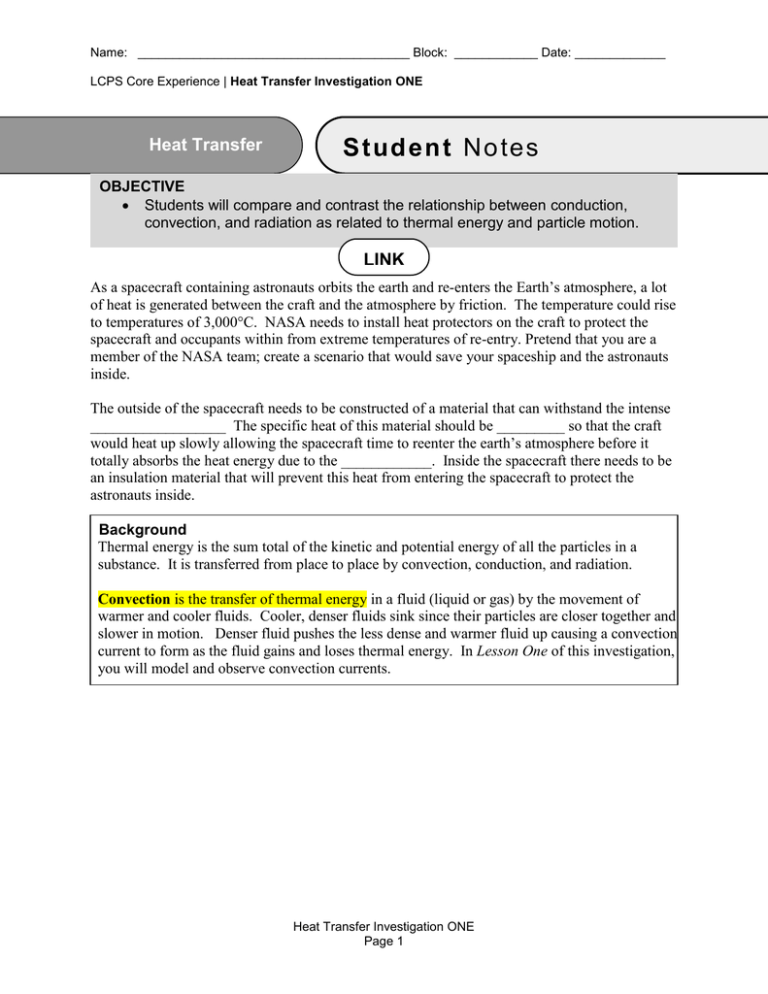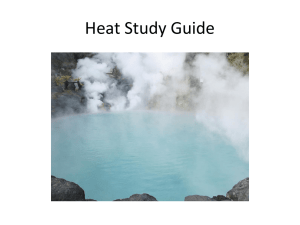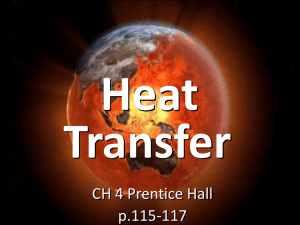Name: _______________________________________ Block: ____________ Date: _____________
advertisement

Name: _______________________________________ Block: ____________ Date: _____________ LCPS Core Experience | Heat Transfer Investigation ONE Heat Transfer Stu de nt No tes OBJECTIVE Students will compare and contrast the relationship between conduction, convection, and radiation as related to thermal energy and particle motion. LINK As a spacecraft containing astronauts orbits the earth and re-enters the Earth’s atmosphere, a lot of heat is generated between the craft and the atmosphere by friction. The temperature could rise to temperatures of 3,000°C. NASA needs to install heat protectors on the craft to protect the spacecraft and occupants within from extreme temperatures of re-entry. Pretend that you are a member of the NASA team; create a scenario that would save your spaceship and the astronauts inside. The outside of the spacecraft needs to be constructed of a material that can withstand the intense __________________ The specific heat of this material should be _________ so that the craft would heat up slowly allowing the spacecraft time to reenter the earth’s atmosphere before it totally absorbs the heat energy due to the ____________. Inside the spacecraft there needs to be an insulation material that will prevent this heat from entering the spacecraft to protect the astronauts inside. Background Thermal energy is the sum total of the kinetic and potential energy of all the particles in a substance. It is transferred from place to place by convection, conduction, and radiation. Convection is the transfer of thermal energy in a fluid (liquid or gas) by the movement of warmer and cooler fluids. Cooler, denser fluids sink since their particles are closer together and slower in motion. Denser fluid pushes the less dense and warmer fluid up causing a convection current to form as the fluid gains and loses thermal energy. In Lesson One of this investigation, you will model and observe convection currents. Heat Transfer Investigation ONE Page 1 LCPS Core Experience | Heat Transfer Investigation ONE Lesson One: Observing Convection Currents EXPERIMENT (Use caution when working with hot materials.) 1. Pour 500 mL of water into the beaker. 2. Sprinkle about ¼ - ½ cup of macaroni into the beaker of water and let it settle to the bottom of the beaker. 3. Heat the bottom of the beaker using the hot plate. Observe for 5 minutes. 4. Turn off the hot plate and let the beaker cool before empting the water. 5. Observe what happens to the macaroni as the water cools. 6. Answer questions 1-3 below. 7. Light the candle and blow out the flame. Observe the motion of the smoke. 8. Answer questions 4 and 5. Questions 1. What did you observe the macaroni doing as the water heated? The particles of macaroni will swirl ____________. 2. Explain how a convection current formed in the beaker. The water was ________ in the bottom of the beaker because it was nearer the heat source. The hot water______ in the beaker and the cool water ______creating a convection current. 3. Explain why the motion of the macaroni changed when the heat was turned off. There was no longer a ___________ __________ in the beaker so convection stopped. 4. Describe how the smoke particles moved when the candle was blown out. The smoke ________as long as there was a heat source. The rise of the smoke became ________ as the wick cooled. 5. Explain why the smoke moved as it did. Smoke particles were ________ u__________ by the convection currents in air. Heat Transfer Investigation ONE Page 2 LCPS Core Experience | Heat Transfer Investigation ONE Background Conduction is a method of heat transfer by the collisions between particles in matter. Conduction occurs because particles are in constant motion. When collisions occur between particles, the kinetic energy is transferred to nearby particles with less kinetic energy. As the collisions continue, thermal energy is transferred from particle to particle until the entire substance is in equilibrium. When heat is transferred by conduction, thermal energy is transferred from place to place without transferring matter. Energy is transferred by particle collisions, not by movement of matter. Lesson Two: Observing Conduction EXPERIMENT 1. Take the initial temperature of the two thermometers. Record the temperatures in Table A. 2. Fill the flask with 350 mL of water and cover the mouth of the flask with aluminum foil. Poke 2 holes in the foil for the thermometers. 3. Place the thermometers into the flask making sure the foil is submerged into the water and the other thermometer is above the water. 4. Place the flask on a hot plate, turn it on and heat for 10 minutes. Record the temperature every 2 minutes and record this data in Table A. 5. Turn off the hot plate. Remove the thermometer from the flask, and using hot hands protection, remove the flask from the hot plate. Heat Transfer Investigation ONE Page 3 LCPS Core Experience | Heat Transfer Investigation ONE Table A: Measurement of Water Temperature Over Time Time in Thermometer Thermometer Without Seconds With Cu or Al Strip (°C) Cu or Al Strip (°C) 26 26 0 2 min 29 27 4 min. 38 35 6 min. 46 41 8 min. 56 50 10 min. 67 60 6. Graph A: Using the data from Table A, plot a graph of time versus temperature for each thermometer on the same graph paper. a. Determine which variable is the independent variable and which is the dependent variable. Label each axis appropriately. b. Title your graph. Heat Transfer Investigation ONE Page 4 LCPS Core Experience | Heat Transfer Investigation ONE Questions 1. In the space provided, calculate the total temperature change for both thermometers by subtracting the initial temperature from the final temperature. 2. In the space provided, calculate the average rate of temperature change for each thermometer by dividing the total temperature change by 10 minutes. 3. Describe how heat was transferred by conduction. The copper (or aluminum) foil is touching the hot water in the beaker and heat is conducted directly to the thermometer through ____ _______ . 4. Explain why the average rate of temperature change is different for each thermometer. The thermometer attached to the foil was heated by ___________, so the thermometer registered a _________temperature at a faster rate. Heat had to be transferred by ____________ to the other thermometer. Because heat moves more_________ through air, it took more time for heat to reach this thermometer and the temperature change of this thermometer occurred more slowly. Heat transfer by convection is _________ efficient than heat transfer by conduction. Background Radiation is the transfer of energy by electromagnetic waves. These waves can travel through space even when no matter is present. This type of energy is often called radiant energy. When radiant energy strikes a surface, some of the energy is absorbed, some is reflected, and some may be transmitted through the material. The transfer of energy by radiation is most important in gases. In a solid, liquid or gas, radiant energy can travel through the space between molecules. Molecules can absorb this radiation and emit some of the energy they absorbed. This energy then travels through the space between molecules, and is absorbed and emitted by other molecules. Since molecules are much farther apart in gases than in solids or liquids, radiation usually passes more easily through gases than through solids or liquids. Lesson Three: Observing Radiation EXPERIMENT 1. Fill one beaker with 50g of sand and the other beaker with 50 g of water. 2. Insert one thermometer into the sand and the other into the water. 3. Record the initial temperature in Table B. Heat Transfer Investigation ONE Page 5 LCPS Core Experience | Heat Transfer Investigation ONE 4. Direct the light source onto the beakers of sand and water while keeping the thermometers in the sand and water. Start the timer. 5. Note the temperature of each substance at 5, 10, and 15 minutes after turning on the light. Record in Table B. 6. After 15 minutes, turn off the light. Record the temperature for the water and the sand, in the 15 minute section of Table B and initial temperature for Table C. 7. Record in Table C the temperature of each substance at 5, 10 and 15 minutes after turning off the light. Table B: The Effect of Radiation on Substance Temperature Time in Minutes Initial Temperature of Sand (°C) 26 Temperature of Water (°C) 26 5 33 27 10 39 29 Table C:15Specific Heat Capacity (The Effect of Cooling Without Light) Time in Minutes Temperature of Sand (°C) Temperature of Water (°C) Initial 39 29 5 41 30 10 36 26 15 35 22 Background As a substance absorbs heat, its temperature change depends on the nature of the substance, as well as the amount of heat that is added. The specific heat capacity of a substance is a value that describes the amount of heat energy (Joules) required to increase the temperature of 1 g by 1oC. When comparing 1 kg of sand to 1 kg of water, the amount of heat that is required to raise the temperature of both 1°C is different. If 1 kg of sand is compared to 1 kg of water, the amount of heat that is required to raise the temperature of both substances 1°C differs. The amount of heat energy is about six times greater for water. Therefore, water would have to absorb five times as much heat as the sand to be at the same temperature. Why do you think this is? Heat Transfer Investigation ONE Page 6 LCPS Core Experience | Heat Transfer Investigation ONE Graph B: Using the data from Table B and Table C to plot a graph of time versus temperature for sand and water on the same graph paper. a. Determine which variable is the independent variable and which is the dependent variable. Label each axis appropriately. c. Draw lines to show the change in temperature of each substance over time. Questions 1. Which substance heated up the most in the 15 minute period? ________________________ 2. Why didn’t both substances heat up at the same rate? _______________________________ __________________________________________________________________________ __________________________________________________________________________ 3. Which substance cooled faster and why? The _______cooled faster because Water has a __________ specific heat, which means it can hold heat longer than sand 4. What caused the temperature of both substances to rise? The sand and the water both received heat from the energy source by the transfer of _________ by __________________ waves. Heat Transfer Investigation ONE Page 7 LCPS Core Experience | Heat Transfer Investigation ONE LEARNING REVIEW List three things that you learned about energy transfer. a. Conduction occurs when __________energy is transferred by ___________ between particles. b. Convection occurs in _________ as warmer and _________ fluid move from place to place. c. Radiation is the ___________ of energy by ________________waves which can transfer energy through empty space. EVALUATION 1. 2. List the three methods of heat transfer and explain each. _______________ is the transfer of energy by electromagnetic waves. _______________is the transfer of thermal energy in a fluid by the movement of warmer and cooler fluid from place to place. _______________is the transfer of thermal energy by collisions between particles in matter. Which method of heat transfer occurred in each examples below? a. a spoon gets hot in a bowl of hot soup ____________________ b. a plant receiving sun to undergo photosynthesis _______________ c. the warming of water in a hot tub___________________________ d. burning your finger on a hot plate __________________________ e. top layer of small pond heating on a hot summer day _______________ 3. Why does radiation usually transfer through a gas more easily than through solids or liquids? In a solid, liquid, or gas, __________ energy can travel through the space between molecules. Molecules can _________this radiation and re-emit some of the energy they absorbed. This energy then travels through the space and on to other ____________ as it is passed through the material. Because molecules are much farther apart in ______ than in solids or liquids, radiation usually passes more ________ through gases than through solids or liquids. 4. Explain how density enables convection to occur? _____________is the transfer of energy in a fluid by the movement of the heated particles. When a fluid is heated, the particles move _________. As the particles move faster, they tend to be farther apart. The fluid expands as its temperature __________. The volume of the fluid increases, but its _______remains unchanged. The result is that the density of the fluid __________. Convection occurs when the warmer, less dense fluid rises above the cooler, _________fluid. 5. During World War II, some machine guns were encased in a metal barrel that was filled with water. Explain why water was used. Water has a ________specific heat, so it takes more energy and heat to raise its temperature. Therefore, it kept the gun barrel__________ than air or most other substances. Heat Transfer Investigation ONE Page 8



